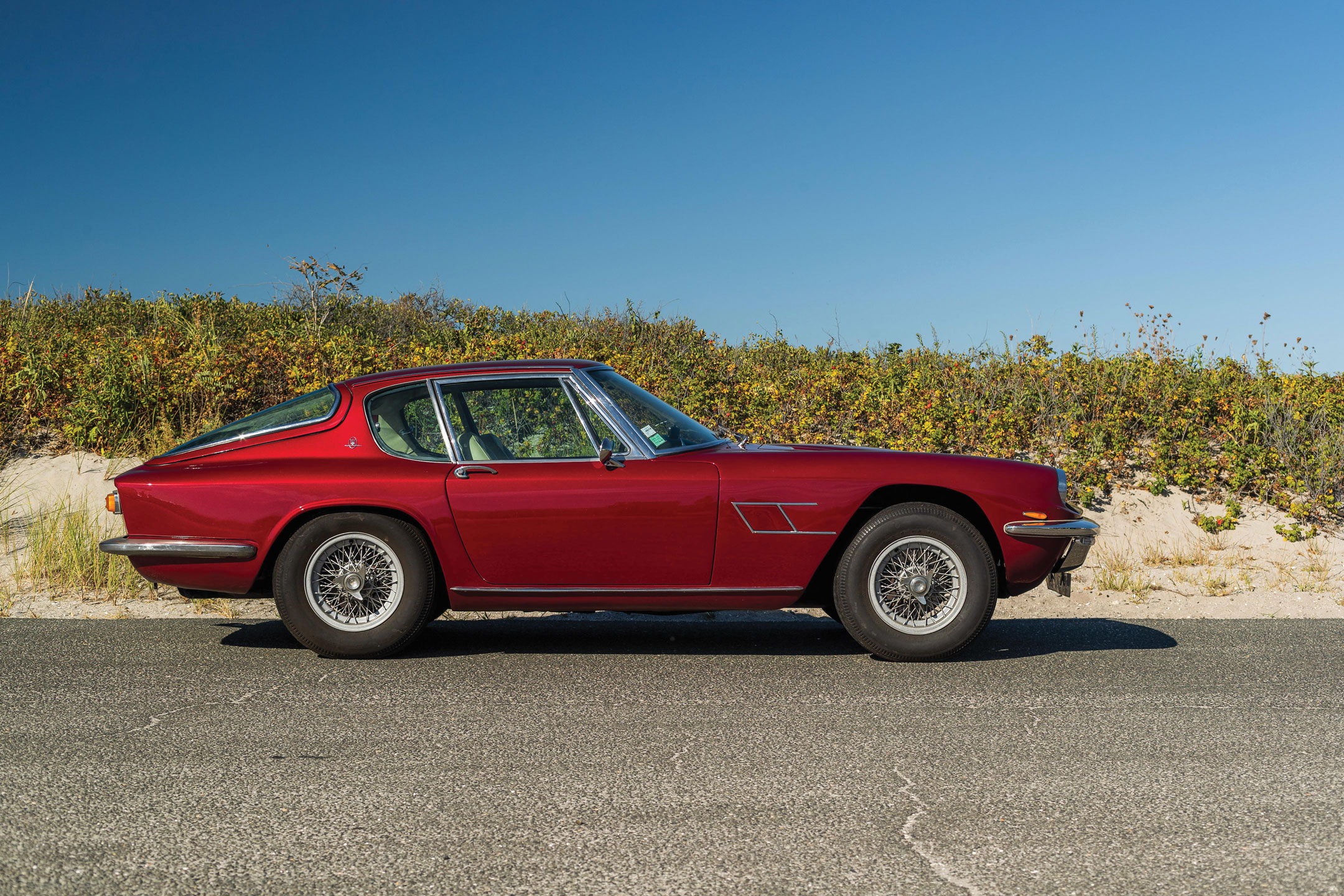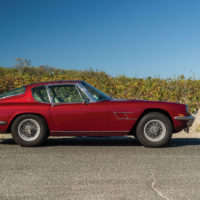Last of the classic 6-cylinder Maseratis, the Pietro Frua-styled Mistral commenced production in 1963. The 3.7-liter version of the famous long-stroke engine was fitted to most cars, other options being the 3.5-liter or, from 1966, the 4.0-liter unit, all of which came with Lucas fuel injection. A handsome 2-seater on a shortened, square-tube chassis, the Mistral was built in coupe and spyder versions, the former’s opening rear window hatch making it unusually practical for a sports car. A 5-speed gearbox, disc brakes and fuel injection were standard equipment; automatic transmission, air conditioning and a limited-slip differential were options. Production ceased in 1970, by which time a total of 827 coupes and 123 spyders had been built.
First registered on June 13, 1967, this particular Mistral has the desirable manual transmission, while the sometimes-troublesome Lucas fuel injection has been replaced with a trio of twin-choke Weber 40DCOE carburetors, a popular modification among owners of these later 6-cylinder Maseratis. Some €10,000 was spent on recommissioning during 2007 to 2008, and in September 2009, the car was offered for sale at Bonhams’ Reims auction (SCM# 142897), where it was purchased by the previous owner.
While in his care, the Mistral benefited from a complete restoration costing around €60,000. This work was completed between 2010 and 2012 by recognized specialists. The odometer reading at time of restoration was 41,500 kilometers, and nearly 46,500 kilometers are indicated at current.
Acquired by the current owner at Bonhams’ February 2014 Grand Palais auction (SCM# 232484), the Maserati has been carefully garaged and sparingly used since purchase. A recent test drive by a Bonhams specialist found the Mistral to come alive at higher revs, producing a sonorous, distinctly Italian exhaust note. Fully restored with no expense spared a decade ago, this beautiful Mistral is finished in Rosso Cordoba with butter-colored leather interior and is presented today in lovely condition. Rarely seen and in the most desirable spec with the largest motor and manual gearbox, this Mistral would be an excellent car for tours, events or local drives.
SCM Analysis
Detailing
| Vehicle: | 1966 Maserati Mistral Coupe |
| Years Produced: | 1964–69 |
| Number Produced: | 844 |
| SCM Valuation: | $115,000 |
| Chassis Number Location: | Stamped on frame member just above left suspension |
| Engine Number Location: | Stamped on rear left just above starter and front of the cylinder head |
| Club Info: | Maserati Owners Club |
| Website: | http://www.themaseraticlub.com |
| Alternatives: | 1965–73 AC Frua, 1968–69 Lamborghini Islero, 1965–70 Aston Martin DB6 |
| Investment Grade: | C |
This car, Lot 131, sold for $114,800, including buyer’s premium, at Bonhams’ Audrain Concours Auction on September 30, 2022.
In 1957, Maserati abruptly abandoned racing, the same year star driver Juan Manuel Fangio must have decided he had enough money in his 401k for an early retirement. For the first time, the firm would be primarily producing road cars. Its first entry was the 3500 GT, a great success, with over 2,200 sold. While this may sound like a small number, it was huge for the small company from Modena.
There and back again
Maserati’s 6-cylinder engine proved to be more than adequate (and quite reliable) and would go on to be used in later models. The firm essentially built only the engine, with everything else outsourced. In the case of the Mistral, the frame was constructed nearby in Modena, then shipped to Maggiora, some 200 miles away. There the body panels were welded to the frame and the car was trucked back to Modena — not to Maserati but to coachbuilder Officine Padane to paint and finish the body. It was then put in the back of a truck and shuttled through the streets of Modena to Maserati, where the engine and suspension would be installed, and the finished car tested. Speculation is that this convoluted production contributed to Maserati making barely any money on each car it sold.
Initially the car was to be named “2 Posti,” or 2-seater. This name comes from the same very literal marketing department that decided to name its 4-door “Quattroporte,” which, of course, translates to four doors. Fortunately, someone had the idea to rename the car after a Mediterranean wind, and “Mistral” was adopted. It is interesting to note that this name can be found nowhere on the car.
The Pietro Frua styling is not universally loved. Some feel the rear hatch makes the car look like an Italian Pacer. Regardless, the workmanship and attention to detail in these cars was excellent, with robust mechanicals and pleasing leather everywhere in the interior. From the start, Maserati road cars were more about elegance and comfort than top speed.
Triple threat
Our subject car has the desirable 4.0-liter engine but has had its Lucas fuel injection replaced with a triple-Weber setup. This was not uncommon back in the 1970s and ’80s, as mechanics would often blame the fuel-injection system they did not understand for an engine not running as it should.
I recall purchasing a Mistral spyder about 20 years ago, and the owner had already bought the replacement Weber parts, as he could not get the engine to start. After I received the car, I found the culprit: A screw that secures the ignition rotor had come loose. With the screw back in its place, the engine ran great for the 12 years I owned the car. No need to swap the Webers for the Lucas injection.
Having said this, however, Webers do make the car easier to maintain, as more mechanics know how to tune them. Although not original, there is no big issue with this conversion, at least not in a car such as this one. Were it a concours-quality example, switching it back would be necessary, as judges are likely to take a dim view of the substitution.
Something borrowed
Conventional wisdom says that obtaining Maserati parts is difficult. While it is true that there are fewer sources when compared to Ferrari or Alfa Romeo, Maserati used mostly off-the-shelf stuff. The Mistral front suspension uses Jaguar parts, the brakes are Girling, the gearbox is from ZF, wiper motors are Lucas, the alternator is Bosch, etc. In my many years of Maserati ownership, with the help of Google and the Maserati group I’ve been able to find everything I’ve needed.
Mistral bodies are aluminum, and while aluminum does not rust, the steel frame behind it does. This leads to electrolysis, which damages the aluminum. Bubbles under the paint are a sure tell, and bodywork on these cars is a lot more difficult than most.
Mistrals are strictly 2-seaters, but they make great rally or tour cars. They have plenty of luggage space, yet they are still nimble, with plenty of torque. They were even sold with optional air conditioning (which is fitted on our subject car).
Undervalued?
Assuming this example holds no immediate surprises, the $115k paid here was market-correct, perhaps even a bit of a bargain depending upon how much recommissioning is necessary. The new owner has an exclusive, coachbuilt Italian exotic at a price that is much less than most competitors from the era. The seller didn’t do nearly as well, paying $149k for the car in 2014 and adding just 180 miles over the ensuing eight-plus years.
Those of us who have been collecting Maseratis for a while have been waiting for the day when people realize how great these cars are and value them at par with their competitors. To the buyer of this car, I would say I hope you plan to keep it for a while, as we are still waiting. ♦
(Introductory description courtesy of Bonhams.)



